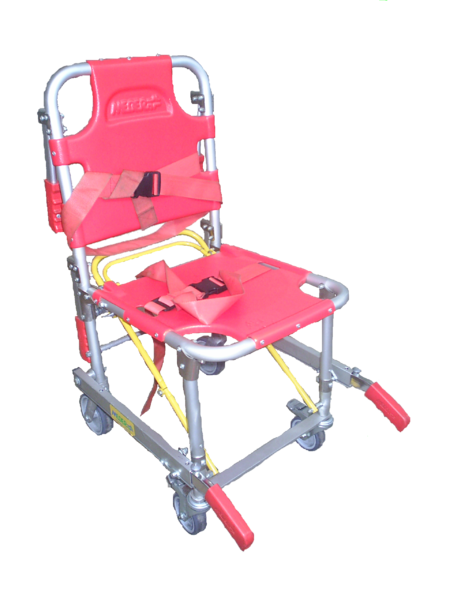Evacuation chair
Contents |
[edit] Introduction
Building evacuation is the process of making sure everyone inside a building gets out safely and in a timely and controlled manner in the event of an emergency, such as a fire. Buildings commonly use equipment such as fire alarms, exit signage, emergency lighting and emergency escape routes to facilitate evacuations.
Multi-storey buildings may also be equipped with evacuation chairs (also known as escape chairs, disabled evacuation chairs, stairway evacuation chairs, fire evacuation chairs or evac chairs) strategically located in protected areas such as corridors or stairways. These devices can be used to assist people with limited mobility (due to an injury, mental health condition, pregnancy or other physical condition) so they can use the stairwell and exit the building safely.
[edit] What is an evacuation chair?
An evacuation chair is a lightweight device that can assist a person with limited mobility to use a stairway. The device is meant to be operated by one person and should require minimal training. It is designed to reduce the amount of heavy lifting that could be required in the event of an evacuation.
Evacuation chairs move at a controlled speed down a portable ramp or track to transport the person to the ground. Some chairs are motorised while others are manually transported.
[edit] Legal requirements
The Regulatory Reform (Fire Safety) Order 2005 (RRFSO) states that it is up to the 'responsible person' (the person in control of the building) to provide a fire safety risk assessment. This assessment should include an emergency evacuation plan along with any evacuation chair requirements.
The assessment should be designed for all people (including those with special mobility requirements - such as visitors) who are likely to be on the premises. This is particularly important in public buildings, healthcare facilities, schools, care homes and other structures that support people with disabilities. In these types of facilities, it is up to the responsible person to make sure the evacuation chairs are in place and in proper working order.
[edit] Related articles on Designing Buildings
- Building evacuation.
- Chair.
- Evacuating vulnerable and dependent people from buildings in an emergency FB 52.
- Protected escape route.
- Protected stairway.
- Responsible person.
- Risk assessment under The Regulatory Reform (Fire Safety) Order 2005.
- The need for company fire risk assessments.
- The Regulatory Reform (Fire Safety) Order 2005.
- Wheelchair user.
Featured articles and news
Infrastructure that connect the physical and digital domains.
Harnessing robotics and AI in challenging environments
The key to nuclear decommissioning and fusion engineering.
BSRIA announces Lisa Ashworth as new CEO
Tasked with furthering BSRIA’s impressive growth ambitions.
Public buildings get half a million energy efficiency boost
£557 million to switch to cleaner heating and save on energy.
CIOB launches pre-election manifesto
Outlining potential future policies for the next government.
Grenfell Tower Inquiry announcement
Phase 2 hearings come to a close and the final report due in September.
Progress from Parts L, F and O: A whitepaper, one year on.
A replicated study to understand the opinion of practitioners.
ECA announces new president 2024
Electrical engineer and business leader Stuart Smith.
A distinct type of countryside that should be celebrated.
Should Part O be extended to existing buildings?
EAC brands heatwave adaptation a missed opportunity.
Definition of Statutory in workplace and facilities management
Established by IWFM, BESA, CIBSE and BSRIA.
Tackling the transition from traditional heating systems
59% lack the necessary information and confidence to switch.
The general election and the construction industry
As PM, Rishi Sunak announces July 4 date for an election.
Eco apprenticeships continue help grow green workforce
A year after being recognised at the King's coronation.
Permitted development rights for agricultural buildings
The changes coming into effect as of May 21, 2024.























